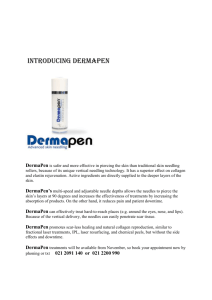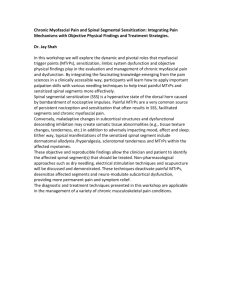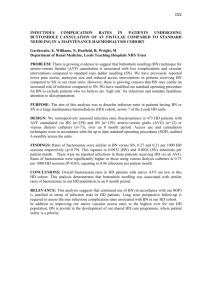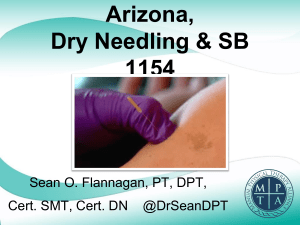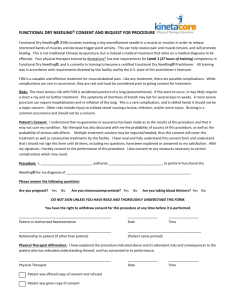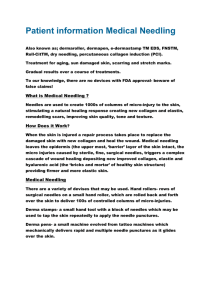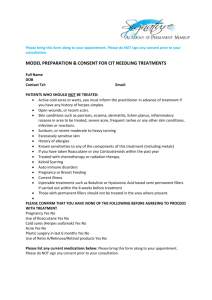Results
advertisement
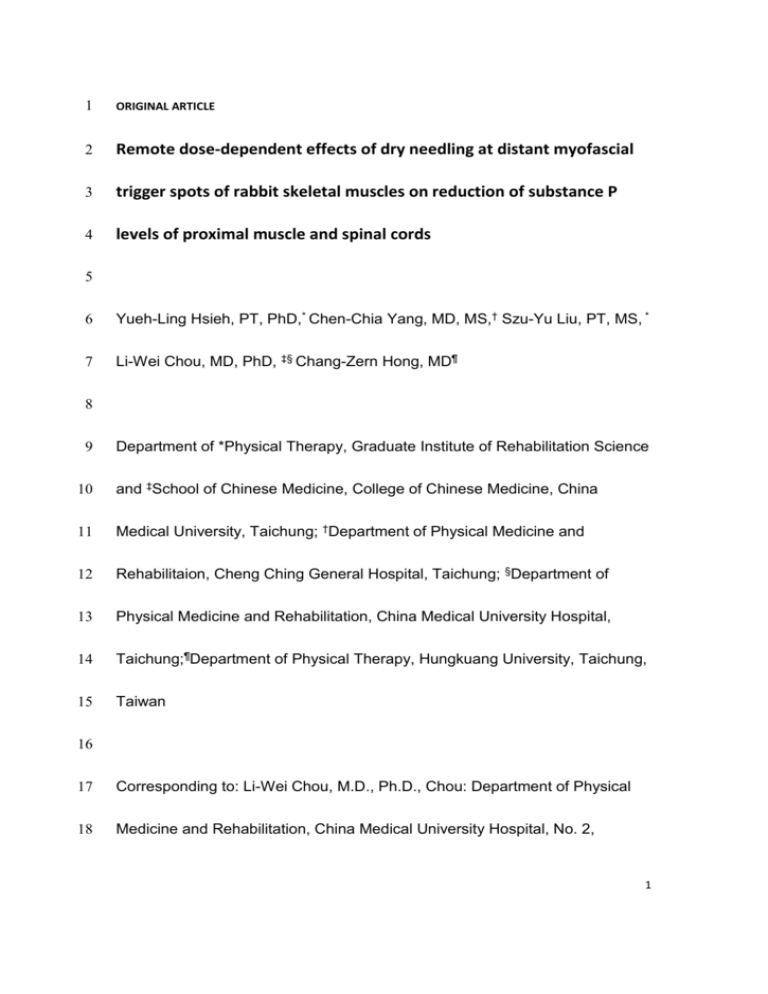
1 ORIGINAL ARTICLE 2 Remote dose-dependent effects of dry needling at distant myofascial 3 trigger spots of rabbit skeletal muscles on reduction of substance P 4 levels of proximal muscle and spinal cords 5 6 Yueh-Ling Hsieh, PT, PhD,* Chen-Chia Yang, MD, MS,† Szu-Yu Liu, PT, MS, * 7 Li-Wei Chou, MD, PhD, ‡§ Chang-Zern Hong, MD¶ 8 9 Department of *Physical Therapy, Graduate Institute of Rehabilitation Science 10 and ‡School of Chinese Medicine, College of Chinese Medicine, China 11 Medical University, Taichung; †Department of Physical Medicine and 12 Rehabilitaion, Cheng Ching General Hospital, Taichung; §Department of 13 Physical Medicine and Rehabilitation, China Medical University Hospital, 14 Taichung;¶Department of Physical Therapy, Hungkuang University, Taichung, 15 Taiwan 16 17 Corresponding to: Li-Wei Chou, M.D., Ph.D., Chou: Department of Physical 18 Medicine and Rehabilitation, China Medical University Hospital, No. 2, 1 19 Yuh-Der Road, Taichung, Taiwan. Tel.: +886-4-22052121 ext. 2381. E-mail 20 address: chouliwe@gmail.com; and Chang-Zern Hong, M.D., Department of 21 Physical Therapy, Hungkuang University, 34 Chung-Chie Road, Shalu, 22 Taichung, Taiwan. Tel.: +886-4-24634393 ext. 3301. Fax: +886-4-22365051, 23 E-mail address: johnczhong@yahoo.com 24 25 Running head: Substance P in remote dry needling for trigger points 26 27 Funding Sources: This study was supported by a grant from National Science Council 28 [NSC 101-2314-B-241-001; 101-2314-B-039 -003 -MY2], China Medical University 29 [CMU-101-S-35], and Cheng Ching General Hospital, Taiwan. 30 31 Conflicts of interest: No commercial party having a direct financial interest in the 32 results of the research supporting this article has or will confer a benefit upon the 33 authors or upon any organization with which the authors are associated. 34 35 What’s already known about this topic? 36 Dry needling at a region some distance away from the painful myofasical trigger 2 37 38 points are already often used to treat myofasical pain in clinical practice. 39 The mechanisms underlying the nociceptive biochemical transmission modulated by remote effects of dry needling are limited and unclear. 40 41 What does this study add? 42 The expressions of pain-related peptide, substance P in the proximal muscle, 43 lumbosacral, thoracic and cervical dorsal horns are analyzed after dry needling 44 with different dosages by needling distant myofascial trigger spots of rabbit’s 45 skeletal muscle. 46 3 47 Abstract 48 BACKGROUND: Dry needling at distant myofascial trigger points is an effective 49 pain management strategy in patients with myofascial pain. However, the biochemical 50 effects of remote dry needling associated with pain relief are not well understood. 51 This study evaluates the remote effects of dry needling with different dosages by 52 needling distant myofascial trigger spots (MTrSs) of skeletal muscle on the 53 expressions of substance P (SP) in the proximal muscle, lumbosacral, thoracic and 54 cervical dorsal horns of rabbits, and explores its underlying mechanism in relieving 55 myofascial pain. 56 METHODS: Male New Zealand rabbits (N = 48, 2.5-3.0 kg) received either dry or 57 sham-operated needling at MTrSs of an unilateral gastrocnemius muscle (distant 58 muscle) for 3 minutes in one session (1D) or five daily sessions (5D). Bilateral biceps 59 femoris muscles (proximal muscles) and spinal dorsal horns of L2-L5, T2-T5 and 60 C2-C5 were sampled immediately and 5 days after dry needling for determining the 61 levels of SP using immunoassays. 62 RESULTS: Immediately after dry needling for 1D and 5D, the expressions of SP 63 were significantly decreased in ipsilateral biceps femoris and bilateral superficial 64 laminaes of spinal dorsal horns when compared with the levels of their sham-operated 4 65 counterparts (p < .05). Five days after dry needling, these reduced immunoactivities 66 of SP were found only in animals receiving 5D dry needling (p < .05). 67 CONCLUSIONS: This biochemical effects of remote dry needling involves the 68 reduction of SP levels in proximal muscle and spinal superficial laminaes, which may 69 be associated with its underlying mechanism in alleviating myofascial pain. 70 5 71 1. Introduction 72 Myofascial trigger points (MTrPs), a source of musculoskeletal pain, has been defined 73 as a hyperirritable (hypersensitive) spot in a taut band of skeletal muscle fibers and 74 may play a key role in the pathophysiology of myofascial pain syndrome (Travell & 75 Simons, 1983). 76 Dry needling targeting directly the primary MTrP, if performed appropriately, is 77 one of the effective therapies for inactivating MTrPs and alleviating pain (Gunn et al., 78 1980; Cummings & White, 2001; Hong, 2002; Itoh et al., 2004; Hsieh et al., 2007; 79 Itoh et al., 2007; Tough et al., 2009; Fernandez-Carnero et al., 2010b; Kietrys et al., 80 2013). However, repetitive and intensive needling manipulation may cause excess 81 damage and increase inflammatory nociception in skeletal muscle fibers (Hsieh et al., 82 2012). Therefore, acupuncture-like needling at a region some distance away from the 83 painful MTrPs can provide an alternative approach to remote pain relief (Chou et al., 84 2009; Tsai et al., 2010; Chou et al., 2011; Chou et al., 2012; Chen et al., 2013). An 85 electrophysiological study investigating the neural mechanism of remote effects of 86 dry needling has found that the effects are mediated via an intact afferent neural 87 pathway from the stimulated site to the spinal cord and via a normal spinal cord 88 function at the segments corresponding to the innervation of the proximally affected 6 89 muscle (Hsieh et al., 2011) and may also involve the possible effects from 90 extrasegments, such as descending pain inhibitory systems (Hsieh et al., 2011). But 91 the biochemical mechanisms underlying the nociception transmission modulated by 92 remote effects of dry needling is still unclear. 93 An animal model for MTrP study on rabbit was established by Hong and Torigoe 94 (Hong & Torigoe, 1994). A certain hyperirritable spot (myofascial trigger spot, MTrS) 95 in the rabbit biceps femoris muscle is similar to that in human MTrP. In this spot, 96 local twitch responses can be elicited when the needle tip encountered a sensitive 97 locus. As in human MTrP, spontaneous electrical activity including endplate noise 98 (EPN) and endplate spike can also be frequently recorded within this sensitive spot 99 (Simons et al., 1995; Simons et al., 2002). This animal model had been used for many 100 studies on myofascial pain syndrome (Simons et al., 1995; Kuan et al., 2002; Kuan et 101 al., 2007; Chen et al., 2008; Chen et al., 2010; Hsieh et al., 2011). 102 The aim of the present study was to evaluate the remote effects of dry needling 103 treatment on the pain-related peptide, substance P (SP), in a rabbit model of MTrSs. 104 The analgesic mechanism of this procedure was elucidated by using 105 electrophysiological EPN recordings and measurements of SP immunolabeling 106 expressions in a rabbit model to assess and compare the alterations of SP levels in the 7 107 proximally affected muscle and to explore the corresponding neuronal circuits 108 affected by remote dry needling. This study is also designed to further investigate the 109 dose-dependent effect of remote dry needling treatment. 110 111 2. Materials and Methods 112 2.1 113 The current experiment was designed to clarify the analgesic effects of dry needling at 114 a distance muscle containing MTrSs (i.e., unilateral gastrocnemius) by quantifying the 115 expressions of SP in the proximally affected muscles (i.e., bilateral bicep femoris 116 muscles) and in the same spinal segment as the points at which the needling 117 stimulation input reaches the dorsal horns (L5-S2), as well as their suprasegments 118 (C2-C5 and T2-T5). The MTrS of the gastrocnemius (i.e., distant muscles) on a 119 randomly selected side was treated with predetermined dosages of dry needling. A 120 total of 48 rabbits were randomly and equally assigned into one of the following two 121 groups: dry needling or sham-operated dry needling treatment as experimental or 122 control groups, respectively. Then the animals in each group were further divided into 123 four subgroups according to the treatment dosages at distant MTrSs of gastrocnemius. 124 The subgroups are (1) 1D group with animals submitted to one dosage of dry needling General design 8 125 (one session), (2) s1D group with animals submitted to one dosage of sham-operated 126 dry needling, (3) 5D group with animals submitted to one dosage of dry needling for 127 five consecutive days (five daily sessions), and (4) s5D group with animals submitted 128 to one dosage of sham-operated dry needling for five consecutive days. Animals were 129 sacrificed at two examined timepoints for SP immunoanalysis, half of the animals in 130 each group on the day immediately after dry needling, and the remaining animals on 131 the fifth day after cessation of dry needling. The experimental design is presented in 132 Fig. 1. 133 134 2.2 Animal care 135 The experiments were performed on adult male New Zealand rabbits (ages from 16 to 136 20 weeks, body weight of 2.5-3.0 kg). The animals were housed individually in 137 standard polycarbonate tub cages lined with wood chip beddings, and had free access 138 to food and water. The cages were placed in an air-conditioned room (25 ± 1°С), with 139 40 dBA and a 12-hour alternating light-dark cycle (6:00 am to 6:00 pm). Each animal 140 was housed and cared for according to the ethical guidelines of the International 141 Association for Study of Pain in animals (Zimmermann, 1983; 1986). Effort was 142 made to minimize discomfort and to reduce the number of animals used. All animal 9 143 experiments were conducted following the procedure approved by the Animal Care 144 and Use Committee of a university in accordance with the Guidelines for Animal 145 Experimentation. The general experimental conditions were essentially the same as 146 those previously described (Chen et al., 2008 ; Hsieh et al., 2011; Hsieh et al., 2012). 147 148 2.3 Identification and stimulation of myofascial trigger spots 149 Before an anesthetic is given, the most sensitive spots (i.e., MTrS) of biceps femoris 150 and gastrocnemius muscles were identified by finger pinch. The animal’s reactions 151 were observed (such as withdrawal of lower limb, head turning, and screaming) to 152 confirm the exact location of an MTrS. These painful regions were marked on the 153 skin with an indelible marker. Then the animals were anesthetized with 2% isoflurane 154 (AErrane, Baxter Healthcare of Puerto Rico, PR, USA) in oxygen flow for induction 155 followed by a 0.5% maintenance dose. Body temperature, monitored by a thermistor 156 probe of a thermometer (Physiotemp Instrument, Clifton, NJ, USA) in the rectum, 157 was maintained at approximately 37.5°C using a body temperature control system 158 comprising a thermostatically-regulated DC current heating pad and an infrared lamp. 159 The muscle of each marked site was grasped between the fingers from behind the 160 muscle and the muscle is palpated by gently rubbing (rolling) it between the fingers to 10 161 find a taut band, which feels like a clearly delineated “rope” of muscle fibers and is 162 roughly 10 mm in diameter. The marked sites were areas designated for dry needling 163 treatment of gastrocnemius or electrophysiological and immunolabeling studies of 164 biceps femoris. 165 166 2.4 Dry needling of gastrocnemius muscle 167 Dry needling technique was similar to that used in our previous study (Hsieh et al., 168 2012). For needling in MTrS of gastrocnemius, the needle (300 μm in diameter, 1.5 169 inches in length, Yu-Kuang Industrial Co., Ltd., Taiwan) was first inserted through 170 the skin perpendicularly at the center of the marked spot and advanced slowly and 171 gently into the muscle. Then simultaneous needle rotation was performed to facilitate 172 fast “in-and-out” needle movement in order to elicit as many local twitch responses as 173 possible. For sham-operated needling, the needle was inserted into the subcutaneous 174 layer of the marked MTrS region at a depth approximately 1-2 mm from the skin 175 surface, without penetrating into the muscle tissues. After insertion, the needle stayed 176 there without further movement for the same period of duration as in dry needling. 177 178 2.5 Recording of endplate noise 11 179 This procedure was performed by an investigator who was blind to the group 180 assignment. For EPN assessment, a digital EMG machine (Neuro-EMG-Micro; 181 Neurosoft, Ivanovo, Russia) and monopolar needle electrodes (37 mm disposable 182 Teflon-coated model) were used. The gain was set at 20 μV per division for 183 recordings from both channels. Low-cut frequency filter was set at 100 Hz and the 184 high-cut one was set at 1,000 Hz. Sweep speed was 10 ms per division. 185 The search needle was inserted into the MTrS region in a direction parallel to the 186 muscle fibers at an angle of approximately 60° to the surface of the muscle. After 187 initial insertion just short of the depth of the MTrS, the needle was advanced very 188 slowly with simultaneous slow rotation to prevent it from ‘grabbing’ and releasing the 189 tissue suddenly to advance in a large jump. When the needle approached an active 190 locus (EPN locus), the continuous electrical activity with amplitude higher than 10 191 μV, i.e., EPN, can be recorded. Then the needle was fixed in place to ensure that this 192 EPN can run continuously on the recording screen with constant amplitudes for at 193 least 3 minutes. 194 Five EPN recordings (25 ms each) taken before and 3 minutes after the needling 195 treatment were randomly selected for all groups. The mean amplitude of the five 196 random EPN recordings were analyzed and calculated for a certain measurement 12 197 point for each animal. 198 199 2.6 Tissue preparation 200 Half of the animals in each group were sacrificed on the day immediately after dry 201 needling, and the remaining animals were sacrificed 5 days after dry needling for SP 202 immunoassays. Animals were sacrificed under strong anesthesia by injection of 203 saturated KCl (300 g/mL, intraperitoneal injection). Bilateral biceps femoris muscles, 204 their corresponding segments of L5-S2, and extrasegments of T2-T5 and C2-C5 205 spinal cords were harvested. The spinal cord specimens were fixed in 4% 206 paraformaldehyde (diluted in 0.1 mol/L PBS) and then immersed in 30% sucrose in 207 0.1 mol/L PBS for 2 days at 4°C for immunohistochemical staining. The muscle 208 specimens were homogenized in T-PER™ Tissue Protein Extraction Reagent (Pierce 209 Chemical Co., IL, USA) and the complete cocktail of protease inhibitors (Sigma, NY, 210 USA) for Western blot immunoassay. 211 212 2.7 Western blot analysis 213 Equal amounts of protein were loaded and separated in 10% Tris-Tricine SDS-PAGE 214 gels. The resolved proteins were transferred onto polyvinylidene fluoride membranes 13 215 (Millipore, Bedford, MA, USA). The membranes were blocked in 5% non-fat milk for 216 1 hour at room temperature, and incubated overnight with primary antibodies against 217 SP (1:500, Cat. # orb11399, Biorbyt, Cambridge, UK) and GAPDH (1:2000, ab8245, 218 Abcam Inc. MA, USA) at a dilution of 1:2500 in blocking solution. The blots were 219 then incubated with the horseradish peroxidase-conjugated goat anti-rabbit and 220 anti-mouse IgG secondary antibody (1:2000, Jackson ImmunoResearch Laboratories, 221 Inc., West Grove, PA, USA) for 1 hour at room temperature. The signals were finally 222 visualized using an enhanced chemiluminescence detection system (Fujifilm 223 LAS-3000 Imager, Tokyo, Japan), and the blots were exposed to X-ray. All western 224 blot analyses were performed at least three times, and consistent results were obtained. 225 The immunoreactive bands were analyzed using a computer-based densitometry 226 Gel-Pro Analyzer (version 6.0, Media Cybernetics, Inc. USA). Relative intensity of 227 western blot band for each protein was normalized to the level of GAPDH protein and 228 presented as percentage of its sham value. 229 230 2.8 Immunohistochemistry for substance P and quantitative analysis 231 The frozen spinal cord tissues were cut serially and coronally into sections of 4 μm 232 thickness by a freezing microtome. Each spinal cord specimen produced 14 233 approximately 100 sections. Each staining assay was examined in 10 alternate 234 sections per rabbit, which were selected by a systematic-random series with a random 235 start for analysis. The sections were first mounted on poly L-lysine (Sigma, 236 P8920)-coated slides and then blocked in 10% normal goat serum (in PBS with 0.3% 237 Triton X-100, Jackson ImmunoResearch Laboratories, Inc., West Grove, PA, USA). 238 Subsequently, they were incubated overnight at 4C with rat monoclonal anti-SP 239 antibody (1:200, MAB356, Millipore, CA, USA). The sections were then incubated 240 with biotinylated goat anti-rat IgG secondary antibody (1:500, Jackson 241 ImmunoResearch Laboratories, Inc., West Grove, PA, USA) for 1 hour at room 242 temperature. After being washed, the sections were incubated with a 243 streptavidin-horseradish peroxidase conjugate (Jackson ImmunoResearch 244 Laboratories, Inc., West Grove, PA, USA). The sections were visualized as brown 245 precipitates by adding 0.2 mg/mL 3,3′-diaminobenzidine (DAB, Pierce, Rockford, IL, 246 USA) as a substrate. Negative control slides omitting either primary antibodies or 247 secondary antibodies were also prepared for comparison. 248 The slides were examined and photographed at three randomly selected fields of 249 superficial dorsal horn (laminae I-II; superficial, the localization of nociresponsive 250 neurons) at 200× magnification using a light microscope (BX43, Olympus America 15 251 Inc. NY, USA) and a cooled digital color camera with a resolution of 1360 × 1024 252 pixels (DP70, Olympus America Inc. NY, USA). Images were saved and adjusted to 253 equalize contrast and brightness with Adobe Photoshop (CS3, San Jose, CA), no other 254 modifications were made. The digital images were analyzed using a computer-based 255 morphometry, Image-Pro Plus 4.5 software (Media Cybernetics, Silver Spring, USA). 256 According to the automatically calculated parameters, the area labeled by 257 DAB-stained strong-positive staining cells for SP immunoreactivity (SP-IR) was 258 measured. The percentage of the positive and strong SP-IR pixels to total stained 259 pixels in superficial lamina of spinal dorsal horn (%) was analyzed. 260 261 2.9 Statistical analysis 262 All data were expressed as mean ± standard deviation (SD). The differences in SP-IR 263 levels in animals submitted to dry needling and sham operation were calculated. 264 One-way analysis of variance (ANOVA) was employed to determine the differences 265 in SP-IR levels among groups. Post hoc comparisons between groups were examined 266 using Scheffe’s method. A p value of < .05 was considered statistically significant. 267 All data were analyzed using SPSS version 12.0 for Windows (SPSS Inc., IL, USA). 268 16 269 3. Results 270 3.1 271 distant MTrSs 272 Figure 2 shows the alterations of mean EPN amplitude recorded from biceps femoris 273 ipsilaterally and contralaterally to the dry needling side at gastrocnemius muscle. As 274 can be seen, there were significant differences among the four groups at any examined 275 timepoint (ANOVA, all p < .05). Compared with the pre-treatment levels, the EPN 276 amplitudes of ipsilateral biceps femoris were significantly decreased immediately 277 after dry needling treatment (p < .05; Fig. 2A). However, the EPN amplitudes after 278 sham-operated needling showed no marked changes (p > .05). There were also 279 significant differences in EPN amplitudes recorded immediately after treatment 280 between dry needling and sham-operation groups at any dosage (1D vs. s1D, 5D vs. 281 s5D, all p < .05; Fig. 2A). Five days after treatment, the marked reduction in EPN 282 amplitude was no longer observed in the 1D group (1D vs. s1D, p > .05). However, 283 the 5D group showed significant decrease in EPN amplitude when compared with the 284 s5D group (5D vs. s5D, p < .05; Fig. 2A) and the 1D group (1D vs. 5D, p < .05; Fig. 285 2B). The EPN recordings from biceps femoris contralaterally to the dry needling side 286 presented similar trends of amplitude changes (Fig. 2C). Changes in amplitudes of EPN in biceps femoris induced by dry needling at 17 287 288 3.2 Changes in SP-IR of biceps femoris induced by dry needling at distant MTrSs 289 Figure 3 presents the SP-IR in biceps femoris immediately and 5 days after treatments 290 for all groups. As can be seen, there were significant differences among the four 291 groups at any examined timepoint (ANOVA, all p < .05). Immediately after treatment, 292 1D and 5D groups showed significant decrease in SP-IR levels in biceps femoris 293 ipsilaterally to the needling side when compared with s1D and s5D groups, 294 respectively (Scheffe’s method, 1D vs. s1D, 5D vs. s5D, all p < .05; Figs 3A and 3B). 295 Five days after treatment, the 5D group still showed marked decrease in SP-IR levels 296 when compared with the s5D group (Scheffe’s method, p < .05) but there was no 297 difference in SP-IR levels between 1D and s1D groups (p > .05; Fig. 3B). Moreover, 298 there were no significant differences in SP-IR in biceps femoris contralaterally to the 299 needling side between 1D and s1D, as well as 5D and s5D groups at any examined 300 timepoint (Scheffe’s method, 1D vs. s1D, 5D vs. s5D, all p > .05; Fig. 3C). 301 302 3.3 Changes in SP-IR cells of spinal dorsal horns induced by dry needling at 303 distant MTrSs 304 3.3.1 SP expressions in L5-S2 segments 18 305 The SP-IR patterns in L5-S2 segments for the four groups immediately and 5 days 306 after treatments are presented in Figs 4A and 4B, respectively. Qualitative analysis of 307 the SP-IR in superficial laminaes of the L5-S2 dorsal horn showed different patterns 308 of reactivity between dry needling and sham-operation groups (Fig. 4C). There were 309 significant differences among the four groups at any examined timepoint (ANOVA, 310 all p < .05). In sham-operated controls, SP-IR was expressed bilaterally in the nuclei 311 of cells of the superficial laminaes in L5-S2 dorsal horn spinal cords, which showed 312 no statistically significant differences between s1D and s5D groups at each examined 313 timepoint (Scheffe’s method, p > .05; Fig. 4C). The nuclei of SP-IR neurons were 314 visualized as brown precipitates and there was also some cytoplasmic staining. Most 315 of the SP-IR cells were distributed in the bilateral superficial laminaes (I-II) of the 316 dorsal horn. Immediately after treatment, 1D and 5D groups showed significant 317 reduction in SP-IR levels in bilateral superficial laminaes when compared with s1D 318 and s5D groups, respectively (Scheffe’s method, 1D vs. s1D, 5D vs. s5D; all p < .05; 319 Fig. 4A). Overall, the spinal cord sections had faint SP labelings in bilateral 320 superficial laminaes of dorsal horns in both groups submitted to dry needling, as 321 confirmed by the quantitative analysis, which also showed statistically significant 322 differences between 1D and 5D groups (Scheffe’s method, 1D vs. 5D, p < .05; Fig. 19 323 4C). Five days after treatment, there was no significant difference in SP-IR level 324 between the 1D group and the s1D group (Scheffe’s method, 1D vs. s1D, p > .05; Fig. 325 4B). However, the 5D group still showed significant reduction in the SP-IR level in 326 bilateral superficial laminaes when compared with the s5D group (Scheffe’s method, 327 5D vs. s5D, p < .05; Fig. 4B) and the 1D group (Scheffe’s method, 1D vs. 5D, p < .05; 328 Fig. 4C). 329 330 3.3.2 SP expressions in C2-C5 and T2-T5 suprasegments 331 A similar trend of SP-IR expression at L5-S2 segments was also observed in bilateral 332 superficial laminaes at T2-T5 (Fig. 5A) and C2-C5 levels (Fig. 6A). There were 333 significant differences in SP expressions among the four groups at any examined 334 timepoint (ANOVA, all p < .05). Immediately after treatment, 1D and 5D groups 335 showed statistically significant reduction in SP-IR levels in bilateral superficial 336 laminaes at T2-T5 and C2-C5 levels when compared with s1D and s5D groups, 337 respectively (Scheffe’s method, 1D vs. s1D, 5D vs. s5D, all p < .05). In contrast, 338 there were no significant differences between 1D and 5D groups at any examined 339 level (Scheffe’s method, 1D vs. 5D, T2-T5: p > .05; C2-C5: p > .05; Figs 5C and 6C). 340 Five days after treatments, the 1D group showed no significant change in SP-IR at 20 341 T2-T5 and C2-C5 levels when compared with the s1D group (Scheffe’s method, 1D 342 vs. s1D group, p > .05). However, the spinal sections in the 5D group showed a 343 reduction in SP-IR expressions when compared with those in the s5D group 344 (Scheffe’s method, 5D vs. s5D, p < .05; Figs 5B and 6B). The 5D group also showed 345 significant reduction in SP-IR levels in bilateral superficial laminaes when compared 346 with the 1D group at each examined level (Scheffe’s method, 1D vs. 5D, T2-T5: p 347 < .05; C2-C5: p < .05; Figs 5C and 6C). 348 349 3.3.3 Differences in SP-IR patterns among spinal cord levels 350 Comparison among SP-IR patterns of C2-C5, T2-T5 and L5-S2 levels shows no 351 statistically significant differences in either 1D or s1D group at any examined 352 timepoint (ANOVA, p > .05). However, the differences in SP-IR between 5D and s5D 353 groups were significant among various spinal cord levels at all examined timepoint of 354 either immediately or 5 days after treatments (ANOVA, p < .05). The reduction of 355 SP-IR cells in the lumbosacral dorsal horn was significantly higher in comparison 356 with that in cervical or thoracic cells (Scheffe’s method, all p < .05, Fig. 7). 357 358 4. Discussion 21 359 This is the first study showing that short-term and long-term dry needling at distant 360 MTrSs can induce suppression of SP levels in the proximal muscle and spinal cord 361 dorsal horns. The results also suggest that maintenance effects of remote dry needling 362 may contribute to the extra-segmental desensitization effect. There is strong 363 indication that both neural and biochemical effects are involved in the mechanisms of 364 remote pain control. 365 Dry needling targeting the MTrPs for pain relief has its basis in theories similar, 366 but not exclusive, to traditional acupuncture. The electrophysiological outcomes 367 affected by acupuncture and dry needling are similar (Hsieh et al., 2011). In our 368 previous studies, decreases in EPN amplitude in proximal muscles containing MTrSs 369 were found after dry needling at the MTrSs of a distant muscle when compared with 370 pre-treatment baseline EPN amplitude in animals with intact neural circuits (Hsieh et 371 al., 2011). Similar findings were found in humans receiving acupuncture at remote 372 acupoints (Chou et al., 2009; Chou et al., 2011). Fernandez-Camero et al. also found 373 an increase in spontaneous electrical activity at an MTrP region during persistent 374 noxious stimulation at another distant MTrP, followed by suppression of 375 electrophysiological irritability after cessation of needling (Fernandez-Carnero et al., 376 2010a). The evidences reveal that dry needling at distant MTrS could decrease the 22 377 irritability of the proximal MTrS by suppression of EPN in prevalence and amplitude. 378 In the present study, the results obtained are in line with those of earlier studies, 379 showing that EPN amplitudes were significantly reduced after a single or five dosages 380 of dry needling when compared with those after sham operation. 381 SP has been widely proposed as being involved in delivering nociceptive 382 information from the peripheral receptors to the spinal dorsal horn and supraspinal 383 processing centers, thus leading to central sensitization (Hokfelt et al., 1975; Duggan 384 et al., 1988; Xu et al., 2000; Harrison & Geppetti, 2001; Zhang et al., 2007; 385 Kobayashi et al., 2010). Interventions that inhibit SP signaling pathways generally 386 show anti-nociceptive effects in animal models (Mantyh et al., 1997; De Felipe et al., 387 1998). Electroacupuncture can reduce the noxious nerve stimulation-induced release 388 of SP from both central terminals and peripheral endings of the primary sensory 389 neurons (Zhu et al., 1991). Immunohistochemical studies showed that 390 electroacupuncture of ‘‘Zusanli’’ (ST-36) could depress the pain response and inhibit 391 spinal dorsal horn SP release (Du & He, 1992). Electroacupuncture can also suppress 392 immunoreactive SP accumulation induced by tooth pulp stimulation in the superficial 393 layers of the trigeminal nucleus caudalis (Yonehara et al., 1992). Therefore, SP may 394 be an important transmitter in mechanism of acupuncture analgesia. The present result 23 395 on dry needling-induced suppression of spinal dorsal horn SP was consistent with 396 those of previous studies described above, implying that short- and long-term of 397 remote dry needling probably produce analgesic effect. In addition, the finding of 398 reduction in SP expression in extrasegments, dorsal horns of C2-C5 and T2-T5 after 399 dry needling was similar to our previous results (Hsieh et al., 2011), which reported 400 supraspinal control of spinal inhibitory interneurons induced by dry needling at 401 distant MTrSs. The extrasegmental desensitization effect involving a more 402 generalized system of analgesia is probably activated by remote dry needling. 403 SP is also likely to be involved in the pathogenesis of musculoskeletal pain. A 404 recent study has also found higher SP levels in active MTrPs compared with control 405 latent or absent MTPs (Shah et al., 2008). Mean optical density of the 406 immunostaining for SP was statistically greater in trapezius muscle of patients with 407 myofascial pain syndrome when compared with specimens from patients with 408 fibromyalgia. Extensive studies demonstrate that SP accumulated in MTrPs of 409 skeletal muscles is associated with pain and inflammation (Shah et al., 2005; Shah et 410 al., 2008; Hsieh et al., 2011). The current findings of reduction in SP level in 411 proximal muscle (biceps femoris) ipsilateral to the needling side after dry needling at 412 a distant muscle containing MTrSs may be related to pain control. 24 413 Suppression of SP expressions was of a higher extent in animals submitted to 5D 414 dry needling than those submitted to 1D dry needling, indicating immediate 415 dose-dependent effects. On the other hand, five days after cessation of dry needling, 416 the suppression effect persisted and even became more pronounced in laminaes I to II 417 at L5-S2 levels in animals submitted to 5D dry needling, demonstrating prolonged 418 dose-dependent effects. The immediate pain relief by 1D dry needling is probably 419 elicited by the neural effect as demonstrated by changes in EPN. However, the 420 long-term or accumulated effect of pain relief by 5D dry needling may be 421 accompanied by and mediated via biochemical changes in addition to the neural 422 effects. Therefore, repetitive or extensive remote needling may provide better effects 423 on reduction in SP levels for control of myofascial pain. It is commonly accepted that 424 electroacupuncture of higher intensities and longer pulse durations can produce 425 persistent analgesia (Romita et al., 1997). 426 427 5. Conclusion 428 The hypothesis that dry needling at distant MTrSs could modulate irritability of 429 proximal MTrSs by altering the EPN amplitude and SP levels of muscle and spinal 430 cords is supported by the present results. The findings of this study might elucidate 25 431 the biochemical mechanisms induced by remote effects of dry needling. Accordingly, 432 the practice of dry needling at some distance away from the painful site may facilitate 433 decreased MTrP sensitivity in any muscle within the same levels of spinal 434 innervations via activating the mechanisms of segmental and extrasegmental 435 desensitization. Further understanding of the analgesic action of dry needling in 436 treating soft tissue pain can contribute to develop new therapeutic strategies for 437 treating myofascial pain syndrome. 438 439 Author contributions 440 The corresponding author declares that all co-authors have participated sufficiently in 441 the work to take public responsibility for appropriate portions of the content. 442 Associate Prof. Hsieh, Dr. Chou and Dr. Hong take responsibility for the integrity of 443 the work as a whole, from inception to published article. 444 445 References 446 Chen, K.H., Hong, C.Z., Hsu, H.C., Wu, S.K., Kuo, F.C. & Hsieh, Y.L. (2010) 447 Dose-dependent and ceiling effects of therapeutic laser on myofascial trigger spots 448 in rabbit skeletal muscles. J Musculoskelet Pain, 18, 235-245. 26 449 Chen, K.H., Hong, C.Z., Kuo, F.C., Hsu, H.C. & Hsieh, Y.L. (2008) 450 Electrophysiologic effects of a therapeutic laser on myofascial trigger spots of 451 rabbit skeletal muscles. Am J Phys Med Rehabil, 87, 1006-1014. 452 Chen, K.H., Hong, C.Z., Kuo, F.C., Hsu, H.C. & Hsieh, Y.L. (2008) 453 Electrophysiologic effects of a therapeutic laser on myofascial trigger spots of 454 rabbit skeletal muscles Am J Phys Med Rehabil, 87, 1006-1014. 455 Chen, K.H., Hsiao, K.Y., Lin, C.H., Chang, W.M., Hsu, H.C. & Hsieh, W.C. (2013) 456 Remote effect of lower limb acupuncture on latent myofascial trigger point of 457 upper trapezius muscle: a pilot study. Evidence-based complementary and 458 alternative medicine : eCAM, 2013, 287184. 459 Chou, L.W., Hsieh, Y.L., Chen, H.S., Hong, C.Z., Kao, M.J. & Han, T.I. (2011) 460 Remote therapeutic effectiveness of acupuncture in treating myofascial trigger 461 point of the upper trapezius muscle. Am J Phys Med Rehabil, 90, 1036-1049. 462 Chou, L.W., Hsieh, Y.L., Kao, M.J. & Hong, C.Z. (2009) Remote influences of 463 acupuncture on the pain intensity and the amplitude changes of endplate noise in 464 the myofascial trigger point of the upper trapezius muscle. Arch Phys Med Rehabil, 465 90, 905-912. 466 Chou, L.W., Kao, M.J. & Lin, J.G. (2012) Probable mechanisms of needling therapies 27 467 for myofascial pain control. Evidence-based complementary and alternative 468 medicine : eCAM, 2012, 705327. 469 Cummings, T.M. & White, A.R. (2001) Needling therapies in the management of 470 myofascial trigger point pain: a systematic review. Arch Phys Med Rehabil, 82, 471 986-992. 472 De Felipe, C., Herrero, J.F., O'Brien, J.A., Palmer, J.A., Doyle, C.A., Smith, A.J., 473 Laird, J.M., Belmonte, C., Cervero, F. & Hunt, S.P. (1998) Altered nociception, 474 analgesia and aggression in mice lacking the receptor for substance P. Nature, 392, 475 394-397. 476 Du, J. & He, L. (1992) Alterations of spinal dorsal horn substance P following 477 electroacupuncture analgesia--a study of the formalin test with 478 immunohistochemistry and densitometry. Acupunct Electrother Res, 17, 1-6. 479 Duggan, A.W., Hendry, I.A., Morton, C.R., Hutchison, W.D. & Zhao, Z.Q. (1988) 480 Cutaneous stimuli releasing immunoreactive substance P in the dorsal horn of the 481 cat. Brain Res, 451, 261-273. 482 Fernandez-Carnero, J., Ge, H.Y., Kimura, Y., Fernandez-de-Las-Penas, C. & 483 Arendt-Nielsen, L. (2010a) Increased spontaneous electrical activity at a latent 484 myofascial trigger point after nociceptive stimulation of another latent trigger point. 28 485 486 Clin J Pain, 26, 138-143. Fernandez-Carnero, J., La Touche, R., Ortega-Santiago, R., Galan-del-Rio, F., 487 Pesquera, J., Ge, H.Y. & Fernandez-de-Las-Penas, C. (2010b) Short-term effects 488 of dry needling of active myofascial trigger points in the masseter muscle in 489 patients with temporomandibular disorders. J Orofac Pain, 24, 106-112. 490 Gunn, C.C., Milbrandt, W.E., Little, A.S. & Mason, K.E. (1980) Dry needling of 491 muscle motor points for chronic low-back pain: a randomized clinical trial with 492 long-term follow-up. Spine (Phila Pa 1976), 5, 279-291. 493 494 495 Harrison, S. & Geppetti, P. (2001) Substance p. The international journal of biochemistry & cell biology, 33, 555-576. Hokfelt, T., Kellerth, J.O., Nilsson, G. & Pernow, B. (1975) Substance p: localization 496 in the central nervous system and in some primary sensory neurons. Science, 190, 497 889-890. 498 499 500 Hong, C.Z. (2002) New trends in myofascial pain syndrome. Zhonghua Yi Xue Za Zhi (Taipei), 65, 501-512. Hong, C.Z. & Torigoe, Y. (1994) Electrophysiologic characteristics of localized 501 twitch responses in responsive bands of rabbit skeletal muscle fibers. J 502 Musculoskelet Pain 2, 17-43. 29 503 Hsieh, Y.L., Chou, L.W., Joe, Y.S. & Hong, C.Z. (2011) Spinal cord mechanism 504 involving the remote effects of dry needling on the irritability of myofascial trigger 505 spots in rabbit skeletal muscle. Arch Phys Med Rehabil, 92, 1098-1105. 506 Hsieh, Y.L., Kao, M.J., Kuan, T.S., Chen, S.M., Chen, J.T. & Hong, C.Z. (2007) Dry 507 needling to a key myofascial trigger point may reduce the irritability of satellite 508 MTrPs. Am J Phys Med Rehabil, 86, 397-403. 509 Hsieh, Y.L., Yang, S.A., Yang, C.C. & Chou, L.W. (2012) Dry needling at 510 myofascial trigger spots of rabbit skeletal muscles modulates the biochemicals 511 associated with pain, inflammation, and hypoxia. Evidence-based complementary 512 and alternative medicine : eCAM, 2012, 342165. 513 Itoh, K., Katsumi, Y., Hirota, S. & Kitakoji, H. (2007) Randomised trial of trigger 514 point acupuncture compared with other acupuncture for treatment of chronic neck 515 pain. Complement Ther Med, 15, 172-179. 516 Itoh, K., Katsumi, Y. & Kitakoji, H. (2004) Trigger point acupuncture treatment of 517 chronic low back pain in elderly patients--a blinded RCT. Acupunct Med, 22, 518 170-177. 519 520 Kietrys, D.M., Palombaro, K.M., Azzaretto, E., Hubler, R., Schaller, B., Schlussel, J.M. & Tucker, M. (2013) Effectiveness of dry needling for upper quarter 30 521 myofascial pain: a systematic review and meta-analysis. J Orthop Sports Phys 522 Ther, 43, 620-634. 523 Kobayashi, Y., Sekiguchi, M., Konno, S. & Kikuchi, S. (2010) Increased 524 intramuscular pressure in lumbar paraspinal muscles and low back pain: model 525 development and expression of substance P in the dorsal root ganglion. Spine 526 (Phila Pa 1976), 35, 1423-1428. 527 Kuan, T.S., Chen, J.T., Chen, S.M., Chien, C.H. & Hong, C.Z. (2002) Effect of 528 botulinum toxin on endplate noise in myofascial trigger spots of rabbit skeletal 529 muscle. Am J Phys Med Rehabil, 81, 512-520; quiz 521-513. 530 531 532 Kuan, T.S., Hong, C.Z., Chen, J.T., Chen, S.M. & Chien, C.H. (2007) The spinal cord connections of the myofascial trigger spots. Eur J Pain, 11, 624-634. Mantyh, P.W., Rogers, S.D., Honore, P., Allen, B.J., Ghilardi, J.R., Li, J., Daughters, 533 R.S., Lappi, D.A., Wiley, R.G. & Simone, D.A. (1997) Inhibition of hyperalgesia 534 by ablation of lamina I spinal neurons expressing the substance P receptor. Science, 535 278, 275-279. 536 Romita, V.V., Suk, A. & Henry, J.L. (1997) Parametric studies on 537 electroacupuncture-like stimulation in a rat model: effects of intensity, frequency, 538 and duration of stimulation on evoked antinociception. Brain Res Bull, 42, 31 539 289-296. 540 Shah, J.P., Danoff, J.V., Desai, M.J., Parikh, S., Nakamura, L.Y., Phillips, T.M. & 541 Gerber, L.H. (2008) Biochemicals associated with pain and inflammation are 542 elevated in sites near to and remote from active myofascial trigger points. Arch 543 Phys Med Rehabil, 89, 16-23. 544 Shah, J.P., Phillips, T.M., Danoff, J.V. & Gerber, L.H. (2005) An in vivo 545 microanalytical technique for measuring the local biochemical milieu of human 546 skeletal muscle. J Appl Physiol, 99, 1977-1984. 547 Simons, D.G., Hong, C.Z. & Simons, L.S. (1995) Prevalence of spontaneous 548 electrical activity at trigger spots and at control sites in rabbit skeletal muscle. J 549 Musculoskelet Pain, 3, 35-48. 550 551 Simons, D.G., Hong, C.Z. & Simons, L.S. (2002) Endplate potentials are common to midfiber myofacial trigger points. Am J Phys Med Rehabil, 81, 212-222. 552 Tough, E.A., White, A.R., Cummings, T.M., Richards, S.H. & Campbell, J.L. (2009) 553 Acupuncture and dry needling in the management of myofascial trigger point pain: 554 a systematic review and meta-analysis of randomised controlled trials. Eur J Pain, 555 13, 3-10. 556 Travell, J.G. & Simons, D.G. (1983) Myofascial pain and dysfunction: the trigger 32 557 558 point manual. Baltimore: Williams & Wilkins, 1. Tsai, C.T., Hsieh, L.F., Kuan, T.S., Kao, M.J., Chou, L.W. & Hong, C.Z. (2010) 559 Remote effects of dry needling on the irritability of the myofascial trigger point in 560 the upper trapezius muscle. Am J Phys Med Rehabil, 89, 133-140. 561 Xu, G.Y., Huang, L.Y. & Zhao, Z.Q. (2000) Activation of silent mechanoreceptive 562 cat C and Adelta sensory neurons and their substance P expression following 563 peripheral inflammation. J Physiol, 528 Pt 2, 339-348. 564 Yonehara, N., Sawada, T., Matsuura, H. & Inoki, R. (1992) Influence of 565 electro-acupuncture on the release of substance P and the potential evoked by tooth 566 pulp stimulation in the trigeminal nucleus caudalis of the rabbit. Neurosci Lett, 142, 567 53-56. 568 Zhang, H., Cang, C.L., Kawasaki, Y., Liang, L.L., Zhang, Y.Q., Ji, R.R. & Zhao, Z.Q. 569 (2007) Neurokinin-1 receptor enhances TRPV1 activity in primary sensory 570 neurons via PKCepsilon: a novel pathway for heat hyperalgesia. J Neurosci, 27, 571 12067-12077. 572 573 574 Zhu, L.X., Zhao, F.Y. & Cui, R.L. (1991) Effect of acupuncture on release of substance P. Ann N Y Acad Sci, 632, 488-489. Zimmermann, M. (1983) Ethical guidelines for investigations of experimental pain in 33 575 576 577 conscious animals. Pain, 16, 109-110. Zimmermann, M. (1986) Ethical considerations in relation to pain in animal experimentation. Acta Physiol Scand Suppl, 554, 221-233. 578 579 34 580 Figure legends 581 582 Fig. 1. Flow chart for the animal study. Abbreviations: 1D, one-dosage dry needling; 583 5D, five-dosage dry needling; BF, biceps femoris; Gastrocnemius, GAS; MTrS, 584 myofascial trigger spots, SP, substance P; s1D, sham one-dosage dry needling; s5D, 585 sham five-dosage dry needling. 586 587 Fig. 2. Changes in EPN amplitude measured at MTrS of biceps femoris before, 588 immediately and 5 days after one- (1D) and five-dosage (5D) of dry needling at 589 gastrocnemius in experimental (1D and 5D groups) and sham-operated groups (s1D 590 and s5D groups). Sample EPN recordings (A) in rabbits from 1D, s1D, 5D and s5D 591 groups. (B) Quantification of EPN amplitude in biceps femoris ipsilateral (B) and 592 contralateral (C) to dry needling side expressed as mean ± SD. * represents significant 593 difference (p < .05) compared with sham-operated groups (s1D and s5D). # represents 594 significant difference (p < .05) between 1D and 5D groups. †: p < .05, represent 595 significant differences compared with pre-treatment values. 596 597 Fig. 3. Alterations of substance P (SP) level at biceps femoris muscle after one- (1D) 35 598 and five-dosage (5D) of dry needling at gastrocnemius in experimental (1D and 5D 599 groups) and sham-operated groups (s1D and s5D groups). Representative western blot 600 photographs in ipsilateral biceps femoris immediately and 5 days after dry needling at 601 gastrocnemius were shown. Quantification of SP levels in biceps femoris ipsilateral 602 (B) and contralateral (C) to dry needling side expressed as mean ± SD. * represents 603 significant difference (p < .05) compared with sham-operated groups (s1D and s5D). 604 # represents significant difference (p < .05) between 1D and 5D groups. 605 606 Fig. 4. Alterations of substance P (SP) levels at superficial laminaes of L5-S2 after 607 one- (1D) and five-dosage (5D) of dry needling at gastrocnemius in experimental (1D 608 and 5D groups) and sham-operated groups (s1D and s5D groups). The representative 609 photomicrographs indicate immunohistochemical labeling for SP in ipsilateral dorsal 610 horns of lumbosacral spinal cords at the timepoints immediately (A) and 5 days (B) 611 after dry needling. Histograms indicate the quantitative analysis of SP 612 immunoreactivity in ipsilateral and contralateral spinal cords (C). * represents 613 significant difference (p < .05) compared with sham-operated groups (s1D and s5D). 614 # represents significant difference (p < .05) between 1D and 5D groups. (scale bar = 615 100 μm) 36 616 617 Fig. 5. Alterations of substance P (SP) levels at superficial laminaes of T2-T5 after 618 one- (1D) and five-dosage (5D) of dry needling at gastrocnemius in experimental (1D 619 and 5D groups) and sham-operated groups (s1D and s5D groups). The representative 620 photomicrographs indicate immunohistochemical labeling for SP in ipsilateral dorsal 621 horns of lumbosacral spinal cords at the timepoints immediately (A) and 5 days (B) 622 after dry needling. Histograms indicate the quantitative analysis of SP 623 immunoreactivity in ipsilateral and contralateral spinal cords (C). * represents 624 significant difference (p < .05) compared with sham-operated groups (s1D and s5D). 625 # represents significant difference (p < .05) between 1D and 5D groups. (scale bar = 626 100 μm) 627 628 Fig. 6. Alterations of substance P (SP) levels at superficial laminaes of C2-C5 after 629 one- (1D) and five-dosage (5D) of dry needling at gastrocnemius in experimental (1D 630 and 5D groups) and sham-operated groups (s1D and s5D groups). The representative 631 photomicrographs indicate immunohistochemical labeling for SP in ipsilateral dorsal 632 horns of lumbosacral spinal cords at the timepoints immediately (A) and 5 days (B) 633 after dry needling. Histograms indicate the quantitative analysis of SP 37 634 immunoreactivity in ipsilateral and contralateral spinal cords (C). * represents 635 significant difference (p < .05) compared with sham-operated groups (s1D and s5D). 636 # represents significant difference (p < .05) between 1D and 5D groups. (scale bar = 637 100 μm) 638 639 Fig. 7. Differences in substance P (SP) levels at ipsilateral and contralateral 640 superficial laminaes of L5-S2 (L), T2-T5 (T) and C2-C5 (C) between animals after 641 one- (1D) and five-dosage (5D) of dry needling at gastrocnemius in experimental (1D 642 and 5D groups) and sham-operated groups (s1D and s5D groups). * represents 643 significant difference (p < .05) compared with SP levels of thoracic and cervical 644 dorsal horns. 38
